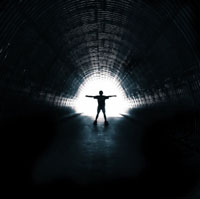Near Death Experience (NDE)

In 1975, Raymond Moody re-ignited an explosion of interest in Near Death Experience through publication of his book, Life After Life. His book documented the experiences of 150 people who recovered after being declared clinically dead. Moody is also credited with coining the term "Near Death Experience", today often shortened to NDE.
In the early 1980s, NDE researcher Kenneth Ring founded the International Association for Near Death Studies (IANDS), which today boasts chapters in the U.K., Europe, Canada, and Australia. Near Death Experience Articles have appeared in several prestigious medical journals such as the Lancet, the British Medical Journal, the Journal of Nervous and Mental Disease, and the American Journal of Psychiatry.
Although Moody is recognized as a pioneer in NDE research, Near Death Experiences have been reported throughout history. Plato describes one in his Republic. Tibetan Buddhist history includes "returned from the dead" writings and NDEs are prevalent in the folklore of the indigenous peoples of North and South America, Australia, and Oceania.1 NDEs have been discussed in modern-day parapsychological literature since the 19th Century.
The NDE transcends gender, age, class, and religious affiliation. As well as those subjects who take part in research studies, many famous people have lived to tell of their Near Death Experience. Mikhail Gorbachev, Roseanne Barr, George Lucas, Debra Winger and Donald Sutherland have experienced NDEs. The once fiery Louis Farrakhan attributes his kinder, gentler message of unity and peace to an NDE. Singer Della Reese, star of the TV series Touched by an Angel and an ordained minister, believes that she encountered angels in a brush with death that occurred due to a burst brain aneurysm.
While the details of Near Death Experiences may differ, many share a common thread. Yet, there are two distinct types of NDE—positive and negative. Researchers estimate that one in ten people have some sort of NDE after surviving a life-threatening event.5
The Negative Near Death Experience

To those who have experienced a negative NDE, the process of dying is, indeed, hellish. People visit dark places, encounter demonic beings, and experience feelings of grief, depression, and fear.1 P.M.H. Atwater, a longtime NDE researcher reports that about 15 percent of adults and 3 percent of children enter "a threatening void or stark limbo or hellish purgatory," sometimes including "hauntings" from the past.7
One of the most vivid portrayals of such a hellish death is in the movie Ghost, where the earth literally opens a passage for the minions of hell to assail the evildoer and pull him into the bowels of the earth. Joyce Harvey, a 75-year-old retired CID officer from Essex experienced such a negative NDE.
While recovering from a chest infection, Ms. Harvey began having breathing problems. Suddenly she was paralyzed by cold. "I started going down and down in a life, with someone pulling my legs which were really hot," she said. "There were terrible noises, discordant notes, and screaming. I could see thousands of faces without bodies beneath me; they were trying to pull me down further and further. I was terrified."4
The Positive Near Death Experience
Often a positive near death experience begins when the person feels his or her consciousness separate and rise from the physical body. During this "out of body" experience (OBE), the subject is totally aware of the activity in the room below. Journalist Neil Marr remembered "watching over the shoulders of doctors and nurses as they hovered" around his bed as he lay with no heartbeat after undergoing a series of five heart attacks.7
Often, the second stage of a positive NDE finds the subject traveling through a tunnel towards a bright light. However, the type of tunnel varies from report to report with descriptions such as a tunnel of tiny stars, spirals of light, the inside of a sewer pipe, or an underground cave.7 Some people meet a deceased friend or relative who either takes them through the tunnel or meets them at the tunnel's end while others give their guides a celestial presence describing them as guardian angels or beings of light. Some people "return to their bodies" never seeing a tunnel, some are pulled back to "life" while journeying through the tunnel, and some are "sent back" by their guide.
Those who pass through the tunnel may go on to other experiences. Many report a sensation of being enveloped by love, peace, and joy. Some subjects undergo a "life review" where they experience both the joy and the mental anguish generated by their earthly actions. Some are "judged" by one or more religious figures while others experience self-judgment as they absorb a feeling of infinite understanding and heightened intellectual abilities.
Those who have encountered religious figures during an NDE, see figures that are familiar from their personal ideologies. That is, Christians don't see Hindu religious figures and Hindus don't encounter Christian figures such as Jesus.2
Some people bring back their visions of supernatural vistas such as celestial gardens flowered with exquisite blossoms in fantastic colors. Some talk of a "city of light" while others reach a boundary where they may be asked or ordered to return to life. In some cases, the decision whether to cross the boundary or not is left up to the subject.6
How NDEs Change Life
Although resulting in somewhat different changes, both positive and negative NDEs produce significant changes in lifestyle.
The person who experiences a negative NDE may return with a greater fear of death and is actually more likely than the positive returnee to seek out organized religion.
Remarkably, although many cultures view suicide in a negative light, those who experience an NDE because of a suicide attempt generally report feelings of joy and peace and return to life with renewed enthusiasm.2
Many of those returning from a positive Near Death Experience report either lessening or losing their fear of death. They also express a greater love for the world around them and often make career or life-style changes that allow them to reach self-fulfillment through working to benefit their fellows. Although they may become more spiritual, their new spirituality may differ from the traditional philosophies found in organized religions.2
Among pioneers in the field of NDE Research is Bruce Greyson of the department of psychiatric medicine at the University of Virginia in Charlottesville and the editor of IAND's Journal of Near-Death Studies. In an interview Greyson related, "What happens is that when [those who have had an NDE] lose their fear of death, they also lose their fear of living life to the fullest because they're not afraid of taking chances anymore. They're not afraid of dying. So they actually get more interested in life and enjoy it much more than they did before."7
Near Death Experience or Biological Melt Down?
Although theories are many, so far traditional science has been unsuccessful at pinpointing any biological cause of NDE.
The role of drugs, both prescription and illegal, has been implicated and impeached as a cause of Near Death Experience; impeached because NDEs often occur in situations that don't involve drugs of any kind.
The chief psycho-neuro-biological theories of NDE have been theories of sensory deprivation or lack of oxygen to the brain. However, such theories often assume that an NDE is associated with a state of unconsciousness. Modern studies that induce NDEs have proven this a false assumption. NDEs may be induced using therapeutic techniques such as eye-movement desensitization and reprocessing (EMDR). Using this technique in grief therapy, living patients have undergone many of the same experiences reported by NDE returnees.1
Theories based on stimulation of receptors in nerve cell membranes called NMDA receptors, on the effects of the neurotransmitter serotonin, and on the level of endorphins have also been proposed.2 However, Ray Moody and other scientists such as cardiologist Michael Sabom believe that none of these theories sufficiently explain the experiences of NDE returnees. Elisabeth Kübler-Ross, a pioneer in the study of death and dying, supports their findings.8
Dr Bruce Greyson, from the University of Virginia, believes that NDEs are part of the way the body copes with unbearable stress. His study of 134 people who had been close to death, published in The Lancet, showed that 72 per cent of them had experienced some form of out of body experience.4
In a 2006 study comparing 55 people with Near Death Experiences with 55 people who had no such experiences, neurologist Kevin Nelson of the University of Kentucky found that people who reported NDEs were also more likely to experience a variance in the brain's sleep-wake cycle, a "REM state intrusion."3 REM is the Rapid Eye Movement phase of sleep when we dream. The intrusion occurs when the subject awakes and feels unable to move, experiences sudden muscle weakness in the legs, or hears noises as they drop off to sleep.5 Neuropsychiatrist Peter Fenwick, coauthor of the study states, "If the mind and brain can be independent, then it raises questions about the continuation of consciousness after death. It also raises the question about a spiritual component to humans and about a meaningful universe with a purpose rather than a random universe." 7
2. COLIN BLAKEMORE and SHELIA JENNETT. "near-death experiences." The Oxford Companion to the Body. Oxford University Press. 2001. HighBeam Research. 16 Jan. 2009 <http://www.highbeam.com>.
3. "Near-Death Experiences Linked to Sleep Cycles." The Washington Post. Washington Post Newsweek Interactive Co. 2006. HighBeam Research. 16 Jan. 2009 <http://www.highbeam.com>.
4. Cherry Norton Social Affairs Correspondent. "Near-death experiences triggered by stress, not delusion or mental illness, says survey." The Independent - London. Independent News & Media. 2000. HighBeam Research. 16 Jan. 2009 <http://www.highbeam.com>.
5. JULIE WHELDON. "A near-death experience? No, you were just dreaming." The Daily Mail (London, England). Solo Syndication Limited. 2006. HighBeam Research. 16 Jan. 2009 <http://www.highbeam.com>
6. MARK FOX. Through the Valley of the Shadow of Death: Religion, Spirituality, and the Near-Death Experience. London: Routledge, 2002. Questia. 16 Jan. 2009 <http://www.questia.com/PM.qst?a=o&d=108421490>.
7. JOHN ELVIN, "In Search of the Soul," Insight on the News 10 Sept. 2001: 10, Questia, 16 Jan. 2009 <http://www.questia.com/PM.qst?a=o&d=5000871094>.
8. "Near-Death Experience," The Columbia Encyclopedia, 6th ed., Questia, 16 Jan. 2009 <http://www.questia.com/PM.qst?a=o&d=112875667>.
